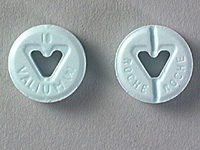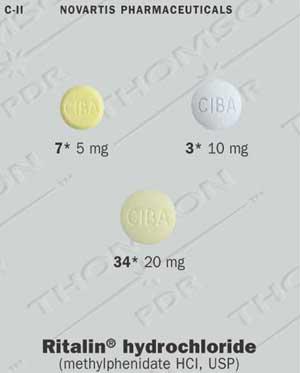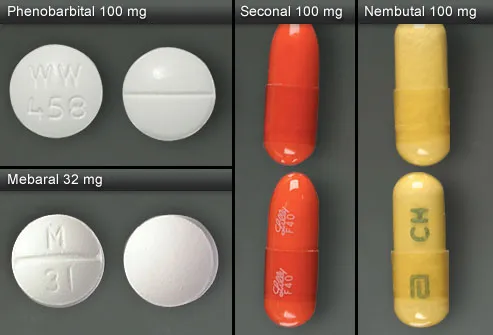Dextromethorphan (DXM)
 Dextromethorphan (DXM) is the active ingredient in nonprescription cough and cold medicines. Those products are safe when taken as recommended, but very large doses can produce euphoria and impaired judgment -- as well as nausea and vomiting, loss of coordination, increased heart rate and blood pressure, and brain damage due to a combination of DXM and decongestants often found in the medication, NIDA says.
Dextromethorphan (DXM) is the active ingredient in nonprescription cough and cold medicines. Those products are safe when taken as recommended, but very large doses can produce euphoria and impaired judgment -- as well as nausea and vomiting, loss of coordination, increased heart rate and blood pressure, and brain damage due to a combination of DXM and decongestants often found in the medication, NIDA says.
Methylphenidate
- Its nicknames include "MPH," R-ball," "Skippy," "the smart drug," and "vitamin R."
- NIDA notes that taking high doses of a stimulant may result in dangerously high body temperature, an irregular heartbeat, and the potential for cardiovascular failure or lethal seizures.
Barbiturates
Prescribed to ease anxiety or promote sleep, depressants slow the brain's function. Barbiturates are a type of depressant. Phenobarbital is a barbiturate; others are Mebaral, Seconal, and Nembutal.
- Though helpful when used as prescribed, barbiturates can be addictive. If taken with certain drugs, including alcohol, the heart and breathing can slow, which can lead to death.
- Slang for barbituates includes "barbs," "reds," red birds," "phennies," "tooies," "yellows," and "yellow jackets."
Benzodiazepines: Valium, Xanax
 Valium and Xanax are examples of benzodiazepines, another type of depressant. They may be prescribed to treat anxiety, acute stress reactions, panic attacks, convulsions, and sleep disorders (typically for short-term use). Like other depressants, they have reasonable uses but may be abused. Withdrawal from benzodiazepines "can be problematic" but is rarely life-threatening, notes the National Institute on Drug Abuse (NIDA).
Valium and Xanax are examples of benzodiazepines, another type of depressant. They may be prescribed to treat anxiety, acute stress reactions, panic attacks, convulsions, and sleep disorders (typically for short-term use). Like other depressants, they have reasonable uses but may be abused. Withdrawal from benzodiazepines "can be problematic" but is rarely life-threatening, notes the National Institute on Drug Abuse (NIDA).Nonbenzodiazepines : Sleep Medicines
 Sleep medicines are depressants. The sleep drugs Ambien, Sonata, and Lunesta are newer sleep medicines called nonbenzodiazepines.
Sleep medicines are depressants. The sleep drugs Ambien, Sonata, and Lunesta are newer sleep medicines called nonbenzodiazepines.- These drugs "may have less potential for addiction" than other depressants, states the web site of the National Institute on Drug Abuse (NIDA).
Opiodes: Codeine and Morphine
Pain relievers are another group of prescription drugs that are commonly abused. They include codeine and morphine -- Oramorph and Aviniza contain morphine.
- Morphine is typically prescribed for severe pain; codeine, for milder pain.
- Street names for codeine include "Captain Cody" and "Cody." Slang for morphine includes "M" and "Miss Emma."
Opioides: OxyContin, Percocet
OxyContin, Percocet, and Percodan share an active ingredient, oxycodone, which is an opiod pain reliever.
- These drugs aren't identical; Percocet also contains acetaminophen while Percodan also contains aspirin.
- These drugs should only be taken under medical supervision, and not with alcohol, barbituates, antihistamines, or benzodiazepines -- those drug combinations could be life-threatening.
- Street names include "oxy," "O.C.," and "oxycotton" for OxyContin and "percs" for Percocet or Percodan.
Opioides : Vicodin, Lortab, Lorcet
 | |||
| Lorcet |
 | |
| Vicodin |
 | |
| Lortab |
Vicodin, Lortab, and Lorcet contain the opioid hydrocodone and acetaminophen. Opioids can cause drowsiness, constipation, and may depress breathing, depending upon the amount taken, the NIDA notes. Vicodin's street names include "vike" and "Watson-387," states the web site of the nonprofit Partnership for a Drug-Free America. Vicodin, or any other prescription drug, shouldn't be shared; they're only for the patient with the prescription.
Amphetamines
 Stimulants increase alertness, attention, and energy. They're prescribed for narcolepsy, attention deficit hyperactivity disorder (ADHD), and depression that doesn't respond to other treatments. The ADHD drugs Dexedrine and Adderall, are stimulants called amphetamines, which may be abused by people seeking a sense of euphoria. Risks include fast or irregular heartbeat, reduced appetite, heart failure, nervousness, insomnia, and addiction. Nicknames for amphetamines include "bennies," "black beauties," and "speed."
Stimulants increase alertness, attention, and energy. They're prescribed for narcolepsy, attention deficit hyperactivity disorder (ADHD), and depression that doesn't respond to other treatments. The ADHD drugs Dexedrine and Adderall, are stimulants called amphetamines, which may be abused by people seeking a sense of euphoria. Risks include fast or irregular heartbeat, reduced appetite, heart failure, nervousness, insomnia, and addiction. Nicknames for amphetamines include "bennies," "black beauties," and "speed."
Pseudoephedrine
Pseudoephedrine is commonly found in nonprescription cold medicines. It's sought as an ingredient for making the illegal drug methamphetamine ("meth"). That's why there are laws limiting the amount of pseudoephedrine-containing drug products that can be purchased at a time.
Identifying a Suspicious Pill
 Found a random pill and want to know what it is?http://www.drugs.com/pill_identification.html
Found a random pill and want to know what it is?http://www.drugs.com/pill_identification.html
There are hundreds of drugs and thousands of pills and tablets of all shapes, colors, and sizes and a best strategy is to take the pill to a pharmacist and ask them for their help in identifying what it is.
Drug Abuse: What to Do
 If you suspect that someone you know is abusing drugs, including prescription or over-the-counter medicines, the NIDA suggests calling 800-662-HELP to find a treatment center. If you're a parent who suspects your child is using, the Partnership for a Drug-Free America provides these tips:
If you suspect that someone you know is abusing drugs, including prescription or over-the-counter medicines, the NIDA suggests calling 800-662-HELP to find a treatment center. If you're a parent who suspects your child is using, the Partnership for a Drug-Free America provides these tips:- Come right out and ask.
- Look for signs and symptoms of drug use.
- Learn the risk factors for drug use, like a family history of addiction or having friends who drink or use drugs.












No comments:
Post a Comment